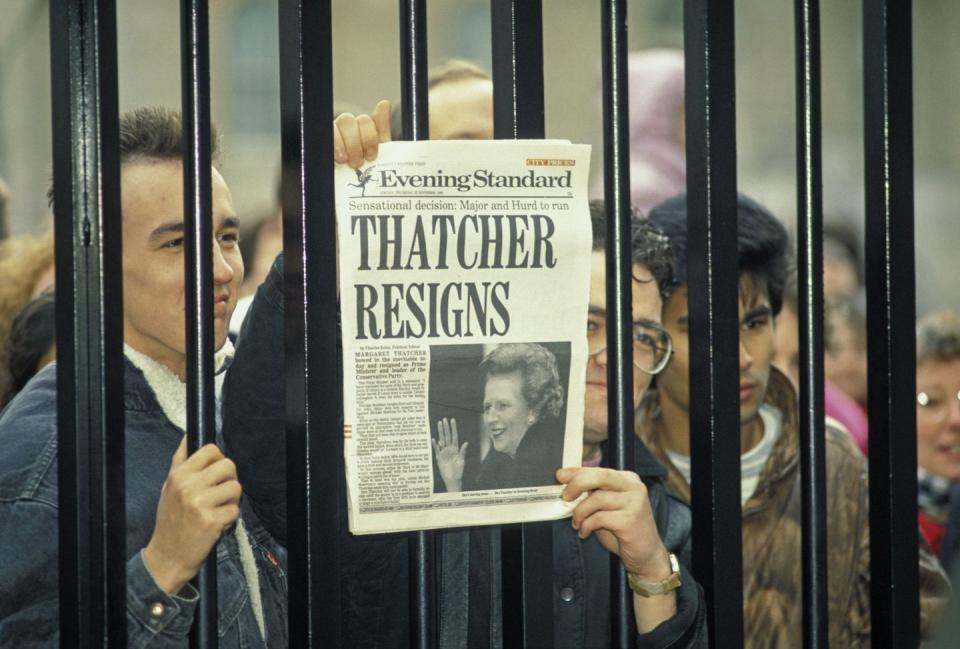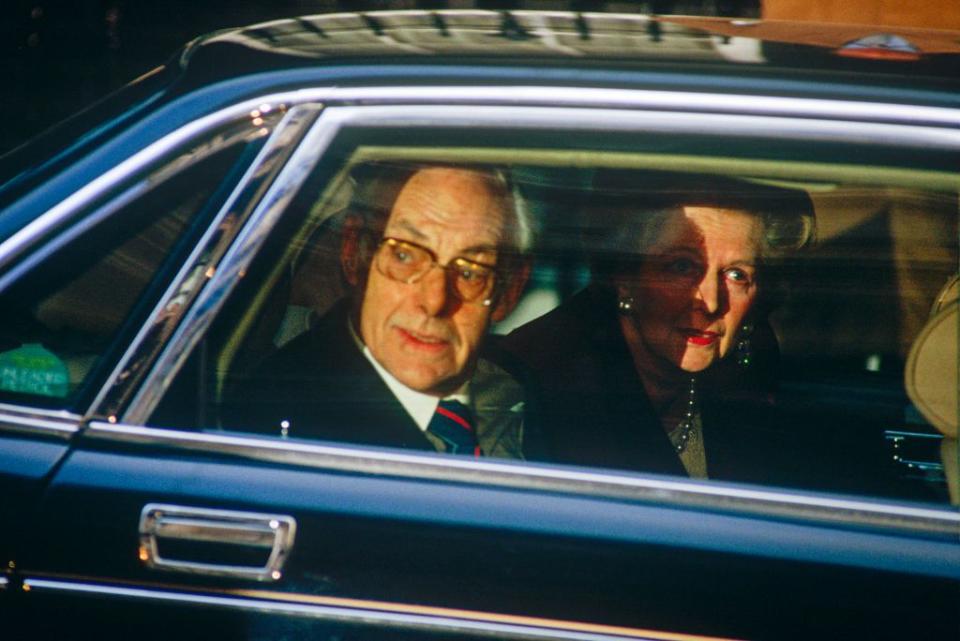'The Crown' Took a Lot of Liberties Depicting Margaret Thatcher's 1990 Downfall

- Oops!Something went wrong.Please try again later.
In the finale of The Crown season 4, the long-overdue breakdown of Charles and Diana's marriage plays out alongside a political meltdown at 10 Downing Street. After three successive election victories made her the longest-serving British prime minister of the 20th century, Margaret Thatcher fell from power in a sudden and dramatic series of events that saw her ousted by her own party. Here's the true story of what happened.
Thatcher's longest-serving cabinet minister, Geoffrey Howe, caused her downfall.
After many years of loyal service, including positions as foreign secretary and deputy prime minister, Howe began to back away from Thatcher. Writing in The Observer, political journalist Andrew Rawnsley detailed the "increasingly visible differences" between Howe and Thatcher, noting that "a chasm [had] opened up between them over Europe." Howe was a passionate believer in "the European ideal," whereas Thatcher was "accelerating on her journey towards europhobia."
In 1989, this tension came to a head when Thatcher dismissed Howe as foreign secretary over Britain's entry into the European Exchange Rate Mechanism. Howe had threatened to resign unless Thatcher agreed to Britain joining the EERM, but Rawnsley notes that Thatcher "thought—rightly, as it turned out—that the ERM was going to be a disaster." As punishment for pushing this issue, Howe was demoted to deputy prime minister. "Any consolation that might have been was stripped away when Thatcher’s press secretary, Bernard Ingham, briefed the media that the title was essentially meaningless,” Rawnsley continued.
In November of 1990, Howe abruptly resigned, and delivered a devastating scorched-earth statement to the House of Commons which, per Rawnsley, "crystallised the fears about Thatcher now swelling in the breasts of many Tory MPs [Members of Parliament]." During the speech, which is depicted in The Crown, Howe criticized Thatcher's treatment of her cabinet and her leadership qualities, culminating with the words, "The time has come for others to consider their own response to the tragic conflict of loyalties, with which I have myself wrestled for perhaps too long.”
Thatcher was unceremoniously booted out of office following an astonishing ten-day downfall in 1990.
After Howe's resignation speech, more dominos started falling. Michael Heseltine, Thatcher's former defense minister, had been considering a leadership challenge for some time, and saw an opportunity now that the PM was weakened. Thatcher narrowly beat Heseltine in the leadership vote, but not by enough to avoid a second round of voting. Conservative Party rules require the winner to be at least 15 percent ahead, which Thatcher was not, and this severely undermined her authority as party leader.
Outwardly, Thatcher projected confidence; on November 20, she famously said: “I shall fight on, I shall fight to win." But Thatcher faced mounting pressure not only from within her own party, but also from the opposition Labour party. Labour leader Neil Kinnock called for a general election after raising a motion of no confidence in the government, but this motion was defeated in Parliament. Privately, Thatcher met with her cabinet in a series of one-on-one meetings during which, according to the BBC, they told her that they didn't believe she could win a second ballot. "After three or four interviews, I felt I could almost join in the chorus," Thatcher later wrote of the ministers' repetitive remarks to her.
This series of meetings, per The Guardian, amounted to "a cabinet revolt," and with no support even from her own ministers, Thatcher had no choice but to resign.

Thatcher was visibly emotional as she left 10 Downing Street.
On November 22, Thatcher resigned from her position as leader of the Conservative Party and therefore as prime minister. On November 27, John Major was elected to the role of Prime Minister, and per BBC History, Thatcher submitted her official resignation to the queen the next day. As she left 10 Downing Street, she addressed the nation in an emotional speech: "Now it’s time for a new chapter to open, and I wish John Major all the luck in the world.”
The Crown dramatizes a moment that became infamous on that day. As Thatcher departed her home of 11 years for the last time, her composure cracked. Photographers captured her looking visibly emotional through the car window, which was uncharacteristic for a prime minister famously dubbed "the Iron Lady."

The Crown's depiction of Thatcher and the Queen's conversations during this period is pure invention.
The two women's interactions during this episode are largely invented, according to BBC History, in particular the exchange where a desperate Thatcher asks the Queen to dissolve parliament. "This is total nonsense," historian Dominic Sandbrook told the magazine. "It’s utterly unthinkable that Thatcher would have asked the Queen to dissolve parliament. It’s such a massive distortion of what happened, and of her character and her relationship with the Queen, that I’m amazed it’s in the series.”
But the queen really did award Thatcher the Order of Merit, which was a hugely significant honor. The Order of Merit is awarded at the sole discretion of the sovereign and is one of the only royal honors that requires no input from government officials. The Queen's decision to honor Thatcher in this way, just two weeks after her resignation, indicates a level of respect that contradicts many reports about their relationship.
You Might Also Like

